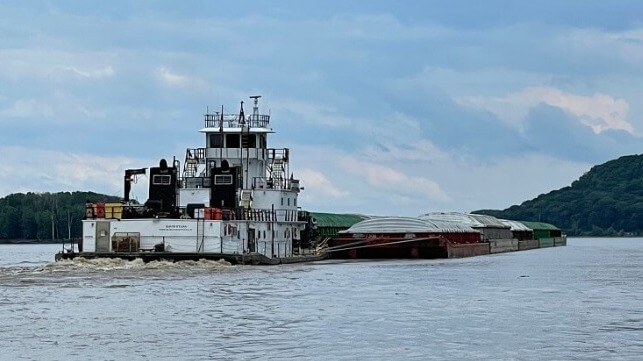Times Are Great for the Inland Marine Market

The inland marine market has been enjoying a welcome renaissance since the summer of last year. While U.S. grain exports remained robust in 2021, movement of coal provided a least-expected additional demand for barges, and a recovering U.S. economy combined with a generous stimulus package further spurred demand for construction and infrastructure.
By the end of the second half of 2021, the market rally in the inland market was in full swing, and by early 2022 many operators were reporting full expected utilization of their hopper fleet for the whole of 2022, with no re-deliveries of tonnage scheduled for the rest of the year.
Strong demand and short supply
On one hand, the U.S. economy has been in a post-COVID-19 recovery mode since late 2021, and thus business activity has been strong as both pent-up and structural demand came back roaring. As such, tonnage demand has been strong.
On the other hand, on tonnage supply, newbuilding costs for new marine assets have skyrocketed, more than doubling for hopper barges since 2021. As a result, newbuilding orders and tonnage growth have come to a standstill. And while newbuilding orders dropped, scrap activity ticked up.
With commodity prices skyrocketing, owners of vintage tonnage got an opportunity to monetize on strong demolition prices for any old languishing tonnage along the riverfront. All in all, the actual hopper barge fleet has shrunk by a small margin. Thus, while demand for cargo and trade has been growing, growth of the fleet (tonnage supply) not only didn’t grow but actually shrank, which partially explains the tightness of the market.
Geopolitical factors
As if domestic market fundamentals have not been strong enough, present global geopolitical events are likely to have an additional favorable impact on the market.
The Russian invasion of Ukraine, irrespective of the logic and moral justification of the invasion, affects the so-called European breadbasket: between Russia and Ukraine, grain exports out of the Black Sea represent approximately 28 percent of the world trade – that is, almost one in three bushels exported globally come out of the Sea of Azov and Odessa.
Unless there’s a fast solution to the military action, it can be assumed that this year's harvest season has been lost in Ukraine and Russia. As a result, grain-importing countries will have to look elsewhere to substitute their grain imports. That bodes well for the U.S., and likely in 2022 the U.S. will be exporting every bushel available, thus boosting demand for inland barge trade. Incidentally, these developments are likely to be positive for the international dry bulk shipping market as well as ton-miles will increase for dry bulk ships.
The second big punch of the Russian invasion in Ukraine is the impact on energy pricing. Europeans, and most notably Germans, have depended too heavily on Russian gas, which now they have to replace. Germany's energy supply was already precarious, as the country switched off three of its six nuclear plants in 2021 and is expected to shut down the remaining three in 2022.
Germany was already importing coal from the U.S. in 2021 for power generation, and in 2022 U.S. coal exports should be even stronger. Moreover, in an age of high oil prices, coal becomes less of an objectionable fossil fuel, and coal trade, whether for export or local consumption, is expected to strongly support the inland market and the blue water dry bulk market as well.
2022 will be a very good year
No wonder then that the inland market has been so robust. On the back of stronger than expected demand in 2021 and geopolitical factors in 2022, commodities traders have put the pedal to the metal; and with few new barges being built and older ones having been scrapped, the market is poised for a very good year.
Our marine appraisal practice has been fielding calls from leasing companies and banks since early this year to the effect: "We financed new barges for a client in 2021, and now the client wants to do more barges but the cost is higher by 40 percent since last year; is this real?" The market is real all right, and a tough call indeed on whether to finance new assets in a market that has appreciated so much so fast.
Playing the devil's advocate, this is probably a good time for a leasing company or a bank to "unload" inland marine assets now that the market is strong and they have better control of the timing. For transactions maturing in the next two-three years, probably a great time to try to sell existing transactions instead of waiting till maturity when residual values could be lower than now.
Whether for operators or lessors with more strategic portfolios, there has been strong demand for acquisition of inland marine assets with a few years of charter remaining. And from the owner / operator’s point of view, there’s been robust desire to put this strong market to work by doing sale & lease back transactions whereby they can monetize on currently strong asset prices and also divest the residual risk.
Perfect storm
The market probably still has some steam to move upwards, but again the perfect storm circumstances may not be around for long. For whatever it is for now, it’s a perfect opportunity to straighten up any underwater or risky positions in one’s portfolio; it's a good opportunity to monetize on assets as well, now that they have appreciated in value so much.
Basil M. Karatzas is the CEO of Karatzas Marine Advisors & Co, a marine appraisals, marine surveys and brokerage firm, active in every aspect and type of marine asset for both domestic and international shipping. The firm employs highly credentialed and qualified marine and finance professionals.
The opinions expressed herein are the author's and not necessarily those of The Maritime Executive.
